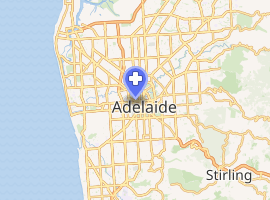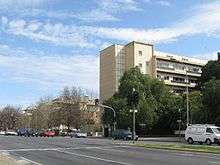Royal Adelaide Hospital
The Royal Adelaide Hospital (RAH) is South Australia's largest hospital, owned by the state government as part of Australia's public health care system. The RAH provides tertiary health care services for South Australia and provides secondary care clinical services to residents of Adelaide's central metropolitan area, which includes the inner suburbs.
| Royal Adelaide Hospital | |
|---|---|
 | |

| |
| Geography | |
| Location | Adelaide, South Australia, Australia |
| Organisation | |
| Care system | Public Medicare (AU) |
| Type | General, Teaching |
| Affiliated university | University of Adelaide |
| Services | |
| Emergency department | Yes |
| Beds | 800 |
| Helipad | Yes |
| History | |
| Opened | Orig. 1840; NRAH 2017 |
| Links | |
| Lists | Hospitals in Australia |
The original Adelaide Hospital was built in 1840 at the eastern end of North Terrace, Adelaide, with its first building superseded in 1856 and many alterations and additions over the following 175 years. It was prefixed by the "Royal" in 1939. In 2017 it was replaced by the new hospital, sometimes referred to as nRAH or NRAH, built at the western end of North Terrace and at the time the most expensive building ever built in Australia, at A$2.3 billion in construction and equipment costs. The redevelopment on the site of the old RAH is known as Lot Fourteen.
History
1841–2017: Original hospital buildings
| RAH – old building (1841–2017) | |||||||||||||||||||||||||||||
|---|---|---|---|---|---|---|---|---|---|---|---|---|---|---|---|---|---|---|---|---|---|---|---|---|---|---|---|---|---|
| |||||||||||||||||||||||||||||
| Links | |||||||||||||||||||||||||||||
| Lists | Hospitals in Australia | ||||||||||||||||||||||||||||

Colonel Light had originally envisaged the hospital in the Eastern parklands.[2]
On 15 July 1840 Lieutenant-Colonel George Gawler, then governor of South Australia, laid the foundation stone for the Adelaide Hospital, which is regarded as the hospital's foundation day, although the first patients were only admitted in January or February of the following year. It was located in the Adelaide Park Lands on the north side of North Terrace, east of Frome Road.[3][4]
In 1856, around the time of the establishment of the Adelaide Botanic Garden to the east, a second building was completed on the site, and the original hospital was used to house patients from the nearby Adelaide Lunatic Asylum, which was sold off to the Botanic Garden.[3][5]
In 1891 the hospital opened its first operating theatre, with rows of raised seating to enable students and others to witness operations. In 1899, only our years after x-ray was discovered, an x-ray facility was opened,[3] by 1939 boasting an extensive X-ray department for the treatment of cancer.[6] The hospital installed its first telephone system in 1901 and performed its first blood transfusion in 1925.[3]
The hospital was officially proclaimed "Royal" on 2 November 1939, at this time the largest general hospital in Australia, and included a modern dental hospital It also functioned as a teaching hospital for medical and dental students, in conjunction with the University of Adelaide[6] (a partnership which has continued to the present day).
The old RAH stood adjacent to both the University of Adelaide (established 1874) and the University of South Australia (established as South Australian School of Mines and Industries on that site in 1889). Its campus was also home to the University of Adelaide's Medical School, the Hanson Institute and SA Pathology.
The old hospital morgue still stands in the Botanic Gardens.[3]
The old RAH included an advanced burns unit, the Adult Burn Centre, led by 2016 SA Australian of the Year, John Greenwood AM[7] and in 2009 became the only burns unit to be verified by the American Burn Association outside of North America.[8]
The Royal Adelaide Hospital was and still is the only provider of hyperbaric oxygen therapy in South Australia.[9] Its Hyperbaric Medical Unit (HMU) opened in 1985.[9][10] The principal treatment equipment as of 2013 was a pair of twin-lock, multi-place hyperbaric chambers. One of these chambers was the first rectangular steel chamber in Australia.[11][12]
After the completion of the new building in 2017, a phased move to the new premises took place, and the old site was designated Lot Fourteen, with various plans mooted regarding its redevelopment. [13]
2017: New building (NRAH)
.jpg)
The new Royal Adelaide Hospital (nRAH) is located on a 10 hectares (25 acres) former railyards site within the Adelaide Park Lands. It is situated on the north side of North Terrace and west of Morphett Street.[14] Starting construction in 2011, it cost more than A$2 billion, making it one of the most expensive buildings ever built.[15] The contractor was a joint venture of Hansen Yuncken and Leighton Contractors.[16] The new Royal Adelaide Hospital (nRAH) was completed in 2017, and the move from the old hospital into the new site was completed over four days, 4–7 September.[17]
More than 6,000 staff are expected to work at the hospital,[14] and all rooms are single patient suites with private bathroom facilities. There are 40 operating theatres, each measuring 65m2.[18] The nRAH is technologically advanced, with a fleet of automated robotic vehicles to help move supplies, meals and equipment around the hospital, and a tailor-made patient electronic medical record (EMR).[19]
The hospital was designed to achieve a 50% reduction in greenhouse gas emissions compared to equivalent hospitals. A co-generation system uses waste heat from energy generators for the domestic hot water system. Orientation of the buildings is optimised to minimise solar thermal loads, with extensive daylight penetration to reduce artificial lighting requirements. Rainwater and stormwater harvesting is used to offset potable water requirements, along with extensive use of water sensitive landscaping and a water efficient thermal plant.[19]
The new hospital was initially to be renamed "Marjorie Jackson-Nelson Hospital" after the former Governor of South Australia, however, in 2009 the RAH name was retained after public opposition and at the former governor's request.[20]
Description
BioMed City
The new RAH forms the largest part of Adelaide's emerging biomedical precinct called BioMed City. Other recently completed facilities in the precinct include the South Australian Health and Medical Research Institute (SAHMRI), the University of Adelaide Health and Medical Sciences building, the University of South Australia's Health Innovation Building, and the state's Dental Hospital.[21][22][23] SAHMRI is building a $300 million second facility due to be completed by 2022 to house the Australian Bragg Centre with Australia's first proton therapy unit.[24] There are also plans for the Women's and Children's Hospital to be relocated to the precinct adjacent the RAH by 2024.[25]
Specialist facilities
Hyperbaric Medical Unit
The HMU, opened at the old RAH in 1985, is the state referral service for diving and hyperbaric medicine. The RAH is the second oldest diving and hyperbaric facility in Australia, and has been responsible for co-ordinating the Divers Emergency Service (DES), a telephone-based consultation service for diving-related matters within Australia, the Southern Pacific and Southeast Asia.[26][27]
See also
References
- Sexton, Mike (1 February 2017). "New Royal Adelaide Hospital: All you need to know about the delayed high-tech project". ABC News. Australian Broadcasting Corporation. Retrieved 30 August 2019.
- "North Terrace (old Royal Adelaide Hospital)". Adelaide Explorer. Retrieved 30 August 2019.
- Williamson, Brett (13 July 2015). "Royal Adelaide Hospital celebrates 175 years of service". ABC News: ABC Radio Adelaide. Australian Broadcasting Corporation. Retrieved 27 August 2019.
- "Royal Adelaide Hospital Heritage Office". South Australian Community History. Retrieved 27 August 2019.
- "Royal Adelaide Hospital". The Advertiser (Adelaide). South Australia. 18 July 1939. p. 16. Retrieved 3 September 2016 – via National Library of Australia.
- ""Royal Adelaide Hospital" Now". The News. XXXIII (5, 078). South Australia. 2 November 1939. p. 9. Retrieved 3 September 2016 – via National Library of Australia.
- "Dr John Greenwood AM". Australian of the Year. Retrieved 30 August 2019.
- "World first in severe burns management". SA Health. 21 June 2019. Retrieved 30 August 2019.
- "Hyperbaric Medicine Unit". Archived from the original on 11 April 2013. Retrieved 3 April 2013.
- Acott, C (1992). "Clinical review Royal Adelaide Hospital hyperbaric medicine unit 1990". Journal of the South Pacific Underwater Medicine Society. 22 (1). Retrieved 3 April 2013.
- "Divers Emergency Service". Archived from the original on 11 March 2004. Retrieved 3 April 2013.
- Williamson, JA (1994). "Royal Adelaide Hospital Hyperbaric Medicine Unit: A progress report". Journal of the South Pacific Underwater Medicine Society. 24 (1). Retrieved 3 April 2013.
- "Lot Fourteen". RenewalSA. Retrieved 18 May 2019.
- HOME | SA Health Partnership
- Campbell-Dollaghan, Kelsey (5 December 2014). "Australia Has Two Of The Most Expensive Buildings Ever Built". Gizmodo Australia. Retrieved 26 December 2014.
- "Royal Adelaide Hospital builder ordered to pay Chinese cladding company almost $2 million". ABC. 9 October 2018. Retrieved 4 January 2020.
- Sale, Charlotte; Page, Deborah; Penniment, Michael (2019). "Change management for radiation therapists – transitioning to the new Royal Adelaide Hospital". Journal of Medical Radiation Sciences. 66 (3): 212–217. doi:10.1002/jmrs.345. ISSN 2051-3909. PMC 6745368. PMID 31317665.
- New Royal Adelaide Hospital, CPB Contractors
- "New Royal Adelaide Hospital". www.designinc.com.au. DesignInc. Retrieved 16 July 2016.
- Owen, Michael (7 June 2007). "800 beds, helipad and train station: Our 'Marj' hospital". The Advertiser. p. 5.
- "Adelaide BioMed City". www.healthindustries.sa.gov.au. Archived from the original on 7 August 2016. Retrieved 17 July 2016.
- "South Australian Health and Biomedical Precinct". Archived from the original on 7 July 2014.
- "Archived copy". Archived from the original on 4 September 2017. Retrieved 4 September 2017.CS1 maint: archived copy as title (link)
- "SAHMRI 2". Commercial & General. Commercial & General. Retrieved 26 August 2019.
- Puddy, Rebecca (30 July 2018). "New women's and children's hospital could cost twice Royal Adelaide Hospital per bed, estimate shows". ABC News. ABC Radio Adelaide. Retrieved 26 August 2019.
- "Hyperbaric Medicine Unit". Royal Adelaide Hospital. Archived from the original on 11 April 2013. Retrieved 17 April 2013.
- "Hyperbaric Medical Unit (HMU)". Royal Adelaide Hospital. Retrieved 30 August 2019.
Further reading
- Scopelianos, Sarah (8 May 2017). "Timeline: New Royal Adelaide Hospital plagued with issues from the start". ABC News: ABC Radio Adelaide. Australian Broadcasting Corporation.
- Sutton, Malcolm (4 September 2017). "What does Australia's most expensive building look like from above?". ABC News: ABC Radio Adelaide. Australian Broadcasting Corporation.